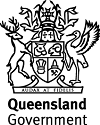Published Monday, 17 December, 2012 at 10:43 AM

Minister for Agriculture, Fisheries and Forestry
The Honourable John McVeigh
30 years of mango magnificence
Agriculture, Fisheries and Forestry Minister John McVeigh is encouraging Queenslanders to eat home grown mangoes this summer and appreciate the history behind each bite.
Today at the Brisbane Markets in Rocklea, Mr McVeigh celebrated the R2E2 mango’s 30th year with a few slices.
“Summertime in Queensland wouldn’t be complete without eating a mango or two,” Mr McVeigh said.
“We are the fruit bowl of the nation and the mango is an iconic Queensland fruit.
“Without a doubt one of the best varieties is our very own R2E2, which has become an international success story.
“The Department of Agriculture, Fisheries and Forestry (DAFF) have been breeding mangoes for a very long time, and in 1982 they struck gold with the R2E2.
“By crossing a Bowen and Kent mango, our researchers came up with a new variety with the same size seed as a Bowen but with a lot more flesh than other varieties.
“This year marks the 30th anniversary of the R2E2, which is now one of Queensland’s best exports thanks to its delicious taste and superior shelf life.
“In 1982, the R2E2 was first selected as a variety with great market potential.
“In 1991, it was released for commercial production and today is exported to more than 30 countries.
“In fact it’s been so successful, the R2E2 accounts for about 70 per cent of mango exports thanks to its large size, good red blush and longer shelf life.
“Customers love it in the Asian markets including China, Hong Kong, Singapore and Malaysia.
“Building on that overseas interest, Queensland company Emu Exports has established large orchards in Vietnam to ensure this Queensland variety is available year round.”
DAFF supports the mango industry with a continuing breeding program to help boost productivity and profitability.
About 7,000 ha of mangoes are grown in Queensland. The main production areas are in the Burdekin, Bundaberg and Mareeba regions.
Apart from the R2E2, varieties grown include Kensington Pride, Calypso, Honey Gold, Keitt, Kent, Palmer, Brooks, Keow Savoey and Nam Doc Mai.
The Queensland mango industry is worth an estimated $70 million annually. The harvest starts in North Queensland in late October and, in southern areas, ends in early April.
Australia’s proximity to Asian markets and world-class cool chain facilities and transport technologies means exported Australian mangoes reach their destination fresh and with a prolonged shelf life.
Storage tips
- Unripe mangoes should never be refrigerated. Store them out of direct sunlight at room temperature for a few days until they ripen.
- Once ripe, they can be stored in the fridge for two to three days before use.
- Mangoes need to breathe—never store them in plastic bags.
- Mangoes freeze really well. They can be sliced and bagged, or pureed and placed into ice cube trays.
Why is it called the R2E2? This particular variety takes its name from the row and position in the field of the original tree at DAFF’s Bowen Research Station.
[ENDS] 17 December 2012
Media: Louise Gillis – 0408 709 160

